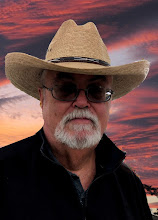This is a pulp that I own and read recently. That’s my copy in the scan, with one of my favorite Sam Cherry covers and maybe the single best depiction of Jim Hatfield that I’ve ever seen. That’s definitely the way Hatfield looks in my head as I read these pulps.
The Hatfield novel in this issue, “The Rimrock Raiders”, is by A. Leslie Scott
writing as Jackson Cole. It centers around the conflict between some cattlemen
in West Texas and the oil wildcatters who are moving into the region. One of
those wildcatters strikes a gusher, resulting in an oil boom town and even more
trouble. Naturally, it’s going to take a Texas Ranger to clean things up and
expose the true villain behind all the problems, and of course that Ranger is
Jim Hatfield.
In addition to knowing a lot about mining and railroading, Scott was also
well-versed in geology and the oil business, and that knowledge comes through
in this novel. I’m a long-time fan of oilfield yarns and this is a good one
with a real sense of authenticity. There are two great scenes, one in which
Hatfield comes up with a unique way of dealing with an oil rig that’s on fire,
the other being the literally explosive climax that’s one of the best I’ve read
in the series. Scott was at the top of his game in this one, which he rewrote
and expanded a few years later into the Walt Slade novel GUNSMOKE OVER TEXAS,
published by Pyramid in 1956. I read that version when I was in high school. I
remembered the cover but nothing about the plot, so it didn’t spoil “The
Rimrock Raiders” for me.
This novel, with its oilfield element, also reminds me of a strange discrepancy
in the Hatfield series. Scott’s entries seem to be set around the turn of the 20th
Century, based on historical references, while the Hatfield novels by Tom
Curry, the other main writer on the series for many years, read more like they’re
set about twenty years earlier, around 1880. The novels by Walker A. Tompkins
and Peter Germano are harder to pin down as to time period, but most of them
seem to me to be set in the 1880s or 1890s. I find these continuity glitches, if
you want to call them that, interesting, but they absolutely don’t bother me. I
just enjoy the stories.
Tex Holt was a house-name used by Leslie Scott, Archie Joscelyn, and Claude Rister
on novels. It also shows up on a dozen or so stories in various Thrilling Group
Western pulps. That’s the by-line on “Ghost Riders of Haunted Pass” in this
issue, a lightweight tale about a couple of drifting cowboys named Jim Norton
and “Hungry” Hill who encounter a couple of phantom owlhoots. The banter between
the protagonists reminded me a little of Syl McDowell’s Swap and Whopper
stories, but not as silly and the story’s action doesn’t descend into slapstick
comedy. It’s an okay story, but I have no idea who wrote it.
“Long Sam Crowns a King” is another entry in Lee Bond’s long-running series
about the good-guy outlaw Long Sam Littlejohn. In this one, set in the South Texas
brush country, Long Sam clashes with an old enemy, a former carpetbagger turned
would-be cattle king. There’s some nice action, and for a change, the
characters don’t stand around explaining the plot to each other. Long Sam’s
nemesis, U.S. Marshal Joe Fry, is mentioned but doesn’t make an appearance.
This is a solid story in a formulaic but consistently entertaining series.
“Red Butte Showdown” is by Jim Mayo, who we all know was actually Louis L’Amour.
This story centers around a mysterious stranger who protects a couple of
orphans (one of whom is a beautiful young woman, of course) from a villain who’s
after the mine they’ve inherited. That plot sounds pretty well-worn, and to
tell the truth, most of L’Amour’s plots were pretty standard stuff. But he was
really, really good at them most of the time, and “Red Butte Showdown” is no
exception. Not only that, but he throws in a pretty good plot twist at the end
of this one. I’ve said for a long time that I think L’Amour was a better short
story writer than he was a novelist, and this is a good example. I enjoyed this
story a lot. It’s probably been reprinted in one of the many L’Amour short
story collections, but I don’t know which.
Barry Scobee’s “Good Country for Murder” is a modern-day Western in which a
park ranger in West Texas’s Big Bend encounters a vicious criminal. It’s a
suspenseful, very well-written yarn that I thoroughly enjoyed. As I’ve
mentioned before, Barry Scobee is the only pulp writer I know of who has a
mountain named for him. It’s just outside Fort Davis, Texas, and was named after
Scobee to honor his efforts in preserving the old military fort there. In
addition to writing for the pulps, he was a newspaper reporter and editor in
West Texas and his work really rings true when it’s set in that region. This is
another very good story by him.
And this is a very good issue of TEXAS RANGERS, as well. A top-notch Hatfield novel,
and four out of the five back-up stories are very good to excellent. The one
story that’s weaker than the others is still entertaining. If you’re a fan of
this pulp, have this issue on your shelves, and haven’t read it, I give it a
high recommendation. (If you want to read the rewritten, Walt Slade version of
the novel, GUNSMOKE OVER TEXAS, it’s available as an e-book on Amazon and would
be well worth your time, too.)



1 comment:
Excellent overview as usual.
Post a Comment